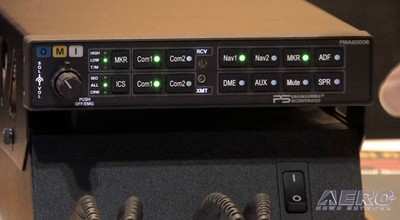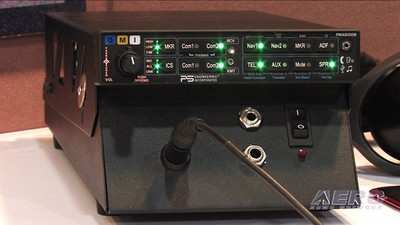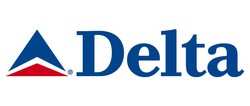Thu, Apr 01, 2010
Company to Revolutionize 'Sleepy' Airlines Avionics Market
ANN April 1st Special Edition: PS Engineering
announced today that Delta Airlines will be the launch customer for
its newest product, the PMW188. In a departure from the
manufacturer's traditional product line, the new device is
described as a marker beacon receiver with enhanced sensitivity,
configured to trigger the playing of an MP3 recording of an alarm
clock through an aircraft's normal audio system to the flight
crew's headphones.

In the event an aircraft is about to overfly the destination
programmed into its flight management system (FMS), the PMW188 is
able to detect the outer marker beacon signal from as high as
Flight Level 450, helping to alert crews to an imminent overshoot
of their destination. To avoid falsing which could disrupt crew
sleep patterns, the unit interfaces to the aircraft's existing
ARINC 429 data bus to identify the destination airport programmed
into the FMS, and reads current GPS position to alarm only over the
correct beacon.

In defending the company's seeming divergence from its core
business in developing the PMW188, PS Engineering Founder Mark
Scheuer explained, "Not at all. This is perfectly in keeping with
the premise of our company. Ever since the days when we were a
two-man shop, soldering through-hole components onto circuit boards
made with carbon tet and a Sharpie in my kitchen sink, our hallmark
has been building products nobody else thought of. This fits right
in."

Because the PMW188 is based on legacy building blocks which are
already TSO'd, the only component needing rigorous testing before
FAA approval is the high-gain antenna for the beacon receiver. The
first units are expected to ship in the third quarter of this year.
Delta will equip its entire fleet with the PMW188, starting with
the former Northwest Airlines flights serving Minneapolis-St Paul
International/Wold-Chamberlain Airport (KMSP).
 Delta CEO Richard H. Anderson
explained the airline's decision to equip its fleet in a
particularly budget-conscious time. "This decision is a no-brainer.
We went to our Human Resources Department, where all the
bean-counters work, and asked them about cost-effectiveness," said
Anderson. "They quickly discovered that the fuel savings achieved
through shortening our average flight duration will pay for the new
equipment by the second quarter of 2011.
Delta CEO Richard H. Anderson
explained the airline's decision to equip its fleet in a
particularly budget-conscious time. "This decision is a no-brainer.
We went to our Human Resources Department, where all the
bean-counters work, and asked them about cost-effectiveness," said
Anderson. "They quickly discovered that the fuel savings achieved
through shortening our average flight duration will pay for the new
equipment by the second quarter of 2011.
"The goodwill generated among our employees by eliminating wake-up
calls from the duties for our professional flight attendants is an
ancillary benefit you can't put a price tag on."
Once fleet-wide deployment is complete, Delta will become eligible
for a $1.6 billion subsidy from the Environmental Protection Agency
for reduction of its carbon footprint.

PS Engineering expects the PMW188 to spawn a more extensive
product line. Scheuer hints that there is already a variant in the
works which uses a relay to actuate a large, mechanical alarm bell
mounted directly to the headrests of cockpit seats. The first
customer is rumored to be Hawaiian Airlines.
More News
“While legendary World War II aircraft such as the Corsair and P-51 Mustang still were widely flown at the start of the Korean War in 1950, a new age of jets rapidly came to >[...]
Decision Altitude (DA) A specified altitude (mean sea level (MSL)) on an instrument approach procedure (ILS, GLS, vertically guided RNAV) at which the pilot must decide whether to >[...]
Aero Linx: National Aviation Safety Foundation (NASF) The National Aviation Safety Foundation is a support group whose objective is to enhance aviation safety through educational p>[...]
Also: Cal Poly Aviation Club, $$un Country, Arkansas Aviation Academy, Teamsters Local 2118 In response to two recent general aviation accidents that made national headlines, more >[...]
“The FAA is tasked with ensuring our skies are safe, and they do a great job at it, but there is something about the system that is holding up the medical process. Obviously,>[...]
 Aero-News: Quote of the Day (04.28.25)
Aero-News: Quote of the Day (04.28.25) ANN's Daily Aero-Term (04.28.25): Decision Altitude (DA)
ANN's Daily Aero-Term (04.28.25): Decision Altitude (DA) ANN's Daily Aero-Linx (04.28.25)
ANN's Daily Aero-Linx (04.28.25) Airborne-Flight Training 04.24.25: GA Refocused, Seminole/Epic, WestJet v TFWP
Airborne-Flight Training 04.24.25: GA Refocused, Seminole/Epic, WestJet v TFWP Aero-News: Quote of the Day (04.29.25)
Aero-News: Quote of the Day (04.29.25)







